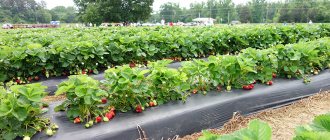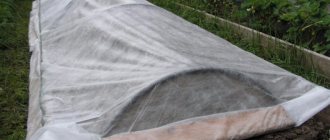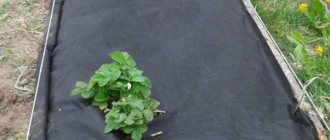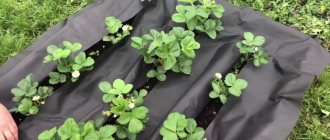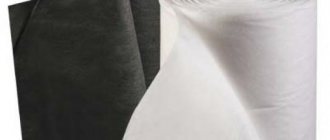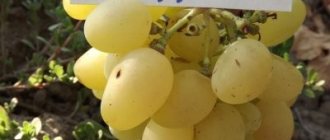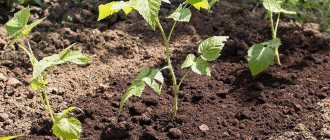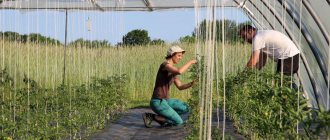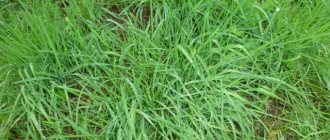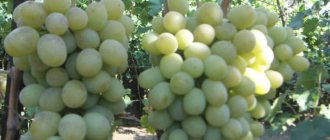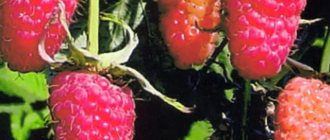Peculiarities
Lutrasil is a non-woven synthetic material based on polypropylene.
To obtain it, the “spunbond” technology is used, which is based on the release of a polymer melt through dies in the form of continuous threads. Thin fibers are laid on a conveyor belt and then fastened together in one of several ways: needle puncture, impregnation with chemical binders, exposure to high temperatures and others, forming a textile fabric. Buy with this product
- Glue
- Tools
- Bracket
- Sintepon
Areas of application
Weed control
Insect protection
Protection against excessive rainfall
Protection from increased solar activity
Frost protection
When mulching the soil
The main advantages of the material:
- affordable price due to low production costs;
- environmentally friendly - does not emit harmful substances;
- safety – does not have a negative effect on crop growth, does not cause mechanical damage to plants;
- wear resistance – resistant to external influences and temperature changes;
- ease of use - easy to cut and place on beds;
- ease of storage - can be folded for a long time without deformation or loss of its properties;
- good air and water permeability - optimal for creating frameless greenhouses and greenhouses.
Advantages and disadvantages of lutrasil
As already mentioned, lutrasil and spunbond are slightly different covering materials that are used approximately equally. Many also use regular polyethylene film . Let's compare these materials:
- Polyethylene film has been used for decades. It is able to retain heat well and protects plants from frost. But at the same time it does not let air and moisture inside. When exposed to sunlight, the film loses its protective properties, breaks and becomes cloudy. It is rare that it can be used for several seasons in a row. It is able to retain moisture in the soil when mulching, but does not cope with weeds. Therefore, in comparison with nonwoven materials, film remains a loser;
- spunbond, like lutrasil, is a polymer non-woven fabric and has many of the same characteristics. However, spunbond, although similar to lutrasil, can be used in a wider range of spheres and have different densities. Also, some of its modifications are equipped with a special additive that blocks harmful solar radiation;
- In terms of breadth of application and resistance to sunlight, spunbond is definitely better than lutrasil. And if you use them as only a covering material, then they have the same characteristics. Lutrasil is popular primarily because it does not require constant supervision, it does not need to be dismantled before watering the soil, and it is also easy to lift as crops grow. Also, the crop is reliably protected from pests, rot and weeds; you don’t have to bend your back for hours to weed the soil.
Comparison of lutrasil with other woven materials
Let's consider the use of different types of woven material.
| View | Application | Advantages | Flaws |
| Polyethylene film | Used as a covering material for seedlings of tomatoes, eggplant, cabbage, peppers and other vegetable crops | Retains heat and moisture, protects from frost | Low light transmittance compared to lutrasil, does not allow water and air to pass through, deteriorates and breaks when exposed to sunlight |
| Reinforced polyethylene film | Most often used for the construction of greenhouses | Resistant to mechanical damage, long service life | Possible overheating of crops |
| Polyethylene air bubble film | For greenhouses and greenhouses | Resistant to mechanical damage, transmits light and reliably retains heat | – |
| Agrofabric | For protection against weeds on strawberries and wild strawberries | Resistant to sunlight, easy to use, protects against pests and diseases, does not rot and lasts more than 5 years | – |
| Polycarbonate | For the construction of greenhouses | Reliable and durable shelter, transmits light, resistant to strong winds | Not suitable for protecting fruit trees and shrubs |
| Shading mesh | For sun protection in greenhouses and open ground | Suitable for trees, vines and shrubs | Not suitable for covering most vegetable crops |
Woven materials are used in cool weather, when the soil has not yet warmed up sufficiently. With the onset of warmer weather, it is better to replace the film with non-woven material (lutrasil and spunbond).
Crops will not burn under Lutrasil, unlike film
Compared to lutrasil, polyethylene film remains a loser. It does not inhibit the growth of weeds and it is impossible to use it for several seasons in a row.
Lutrasil classification
When choosing a particular type of lutrasil, pay attention to its density. It is marked with a number next to the name. Below, let's find out what types of materials of different densities exist and how some of them differ from each other:
Lutrasil Thermoselect 17 - this material is the lightest and thinnest, it has a density of 17 grams per square meter. Its density does not exceed spider webs and can withstand temperatures down to minus 2 degrees;
- Thermoselect 23;
- Frostselect 30 - this material can withstand frosts down to 6 degrees and protect plants from winds, rain and hail. Its density is 30 grams per square meter;
- Frostselect 42 – capable of protecting entire greenhouses and greenhouses;
- Frostselect 60 UV - this material has a black tint due to carbon black, it is elastic and impenetrable to sunlight. If you spread it in the garden, you will certainly protect it from weeds.
So, depending on its density and other functional features, lutrasil is intended for the following tasks:
- mulching the soil;
- protection from unfavorable temperatures for plants;
- protection from precipitation and other atmospheric phenomena;
- weed protection.
When choosing this material, pay attention to how it combines quality, durability and cost.
White
White fabric varies in density:
- 17 g/m2 – the thinnest, suitable for seedlings and plants with thin, fragile stems. Protects against frost down to -2°C. It is enough to cover the bed with a piece of canvas, leaving a small margin for plant growth and pressing down the edges with soil or something heavy;
- 25 and 30 g/m2 are the best option for additional protection of frost-resistant shrubs and trees during cold periods. Can be used as a covering material for greenhouses on supports. Withstands strong winds, hail, heavy rains, frosts down to -6°C;
- 42 and 60 g/m2 – used to create greenhouses and greenhouses at temperatures down to -7°C.
Black
This fabric is elastic and does not allow sunlight to pass through. The black color, which is obtained by adding carbon black to the composition, allows the material to accumulate heat and heat the upper layers of the soil.
This option is used at temperatures down to -10°C. It is also used as mulch to control weeds and protect plant rhizomes from overdrying and hypothermia.
Reviews
In the summer I bought black covering material and planted a bed of strawberries 10 meters long and 3.2 m wide (I could barely find one like this in Krasnodar). The material turned out to be quite dense, but I forgot what it was called, lutrasil or something, but its price was 37 rubles. per linear meter (3 m 20 cm width). I really liked my garden bed. This year in the spring I want to plant tomatoes, peppers, eggplants, zucchini and cucumbers under the same fabric so that I can spend less time fighting weeds and less water on irrigation. I saw rolls (200 meters) on sale in bulk at a price of 2,600 rubles per roll (the width seems to be the same, I didn’t ask about the thickness), i.e. much cheaper, the cost of one linear meter is 13 rubles or 37 rubles, the difference is significant.
IrinaK
https://forum.prihoz.ru/viewtopic.php?t=1775
I cover the strawberries with spandbond so that they bloom early and there are berries earlier. Spandbond is light, like a spider's web, and allows air and moisture to pass through, unlike film. But it retains less heat. Plus it is light, and the plants lift it themselves during growth. There is a non-woven material of black color and a denser texture. It is good for them to cover the ground, make cuts and plant plants there.
Dream-grass
https://gdepapa.ru/forum/family/garden/topic20034/
... Personally, my experience with mulching with black lutrasil was unsuccessful: it is impossible to spill the soil under it and, most importantly, anthills start up, and weeds crawl out of the holes cut for planting, and you have to pull out dandelions and sow thistles directly from the cultivated bush. But, in principle, if the areas are large and only shrubs are intended to be planted, there is probably a point in using lutrasil bedding. And for watering and fertilizing, you can bury bottles with the bottom cut off under the bushes, and poke a few holes in the lutrasil to drain rainwater (the new black lutrasil behaves like a film - it repels water). Under organic mulch without litter, the soil breathes better and its structure improves, but then, in order to suppress the weeds, the mulch must be sprinkled in a very thick layer and no longer rummaged through, otherwise the bark will mix with the soil and weeds will sow again.
imers
https://forum.tvoysad.ru/viewtopic.php?t=1369&start=120
Lutrasil and spunbond are popular synthetic covering materials, durable and strong. They do not have any special differences, so when choosing, you should proceed from the availability of agrotextiles of the required density and try not to overpay.
In some parts of the country, traditional farming is very difficult, so to get a good harvest, crops should be protected from weeds and unpleasant weather conditions. Previously, plantings in the vegetable garden or garden were covered with all sorts of improvised means such as burlap, roofing felt or boards.
Now, with the development of the chemical industry, there are many special materials that are used to protect plantings. One of these covering materials is lutrasil. We will describe below what it is and how it differs from other covering materials. You will also see a photo of this device.
Where is Lutrasil used?
Many amateur gardeners know that this is a very useful material for gardening. For example, if it is necessary to mulch the soil, it is better to use black material, since it will help warm the earth. But most people use the material specifically to cover plants for the winter, for example, the beloved roses.
This method of shelter has many advantages. Firstly, the material is quite inexpensive. Secondly, when stored, it takes up very little space, but it can be used for quite a long time. However, lutrasil also needs to be used wisely.
What to choose?
As already mentioned, today there is a huge amount of materials available that can be used in agriculture. For example, many gardeners do not know what to choose - lutrasil or spunbond. Their doubts are understandable, since these materials are similar in most characteristics. But, for example, lutrasil is most often produced in white and is used mainly for covering beds and crops. At the same time, spunbond is a black material, which is often necessary for mulching the ground immediately before planting plants in it.
In Europe, Lutrasil film has been used for about 20 years and it is popular precisely due to its environmental friendliness and natural fibers. Using it, you can create a closed space above the plants, which will provide them with everything they need - light, air and water. Thanks to the creation of a favorable microclimate, vegetables, fruits and berries will grow much faster, providing their owners with an early harvest.
We invite you to familiarize yourself with Remedies for woodworms and borers
Lutrasil and roses
To begin with, it is worth remembering that roses can withstand temperatures down to – 8 degrees. But if the frosts intensify, then already in November you can start covering the plants. To do this, they are first cleared of unnecessary leaves. The film should be used in two or even three layers of the highest density.
This way you can be sure that the plants will survive the winter successfully. Another important point is that the larger the area you cover, the warmer your plants will be. The minimum you need to cover is one square meter, but it is better to expand the area: in this case, the earth will give off more heat, and your roses will definitely survive even in severe frosts.
If the roses are climbing, then they need to be carefully tied in bunches and then bent to the ground. True, it is necessary to lay, for example, boards or logs on bare soil, so that during the thaw the branches do not get wet and spoil in a puddle. Some rose hybrids do not bend, so they should be trimmed a little - to a maximum of 50 cm from the ground. Ideally, lutrasil should be laid on arches or supports so that under the weight of snow your flooring does not sag and put pressure on the plants.
Covering plantings with lutrasil and useful tips
As we have already said, lutrasil can have different densities and, depending on it, you should choose one or another option for covering your plant crops.
So, if a material with a minimum density is sufficient to cover seedlings of heat-loving plants, then to cover greenhouses with greenhouses you need to choose a denser option. It is very important to choose a covering material so that air can freely penetrate under it. And if there is a need to pollinate the bed , it can be removed for a while.
The service life of the coating also depends on its density. The denser the material, the longer it can be used. And remember that when using such shelter, plants develop better and bear fruit earlier.
If you want to purchase lutrasil for your site, then take into account these useful tips:
- Before rolling out the coating, the soil must be slightly moistened;
- It is best to spread it out first, and only then start planting plants; to do this, you need to make slits in the required places in the form of crosses;
- crops must be covered immediately after seeding. The material is fixed with an ordinary weight, sprinkled with earth, or bent “ears” made of wire are pinned to the ground;
- when punctured, the fabric does not tear beyond the puncture site;
- When watering for the first time, moisture may roll off and not immediately enter the ground. But with subsequent waterings it will go much faster, so do not turn on high pressure to avoid large puddles.
How to use?
The beds are covered with lutrasil immediately after the seedlings are planted or sowing is done. The edges of the material should be sprinkled or laid with stones to prevent the film from being blown away by the wind. If the plants do not need to be pollinated, then it can be left on the ridge until harvest.
Only occasionally can the edges be lifted to allow the plants to develop. During the pollination period, the film is removed. By the way, you can water the plants directly through Lutrasil without removing it.
The material can also be used to cover greenhouses, unheated stationary greenhouses, and also as an additional covering for plants. This will protect the crops from frost and get an earlier harvest.
Using greenhouses, you can save on heating costs. Lutrasil black non-woven is perfect for heating the soil and growing crops that require careful care.
Lutrasil
Lutrasil is a covering material for protecting plantings from adverse natural conditions and weeds, which is a fabric of interwoven threads.
Its advantage lies in its convenient use: it does not need to be dismantled when watering, it can be easily lifted and protects the crop from weeds and pests. Condensation does not form on the surface of lutrasil, so the material can last a long time, moreover, it is non-toxic and does not harm crops or humans.
Lutrasil is divided depending on density:
Latest posts Chainsaw or electric saw - what to choose for the garden? 4 mistakes when growing tomatoes in pots that almost all housewives make Secrets of growing seedlings from the Japanese, who are very sensitive to the soil
- light white - able to withstand temperatures down to -3 ° C and is used mainly for covering seedlings and first shoots;
- white medium and high density - used for winter covering (frost protection down to -6-7°C);
- black medium density and dense - good for weed control (mulching).
Table: properties and applications of lutrasil
| Name | Specifications | Purpose |
| Lutrasil 17 | White light, like a gossamer, but durable canvas with a density of 17 gm2 with high light transmission (at least 92%). Temperature range - up to -2°C. Service life 3 years. | Designed for frameless shelter of plants in spring and summer. The bed with crops or planted seedlings is covered with a cloth, sprinkling it with earth along the edges or pressing it with boards. They are also used in greenhouses and greenhouses for additional shelter from the cold. |
| Lutrasil 30 | A denser (30 gm2) white material that can withstand frosts down to -7°C. | Early spring and late autumn cover for throwing over plants or smooth arches. |
| Lutrasil 40 | Durable, light-colored fabric with a density of 40 gm2 retains heat well. The period of use is 4 years. | It is used for direct covering of bushes and trees during cold periods and as a covering material on arches. |
| Lutrasil 60 white | High-strength (60 gm2), retaining its properties for 4–6 years, material for constructing greenhouses and greenhouses. | It is used instead of film, allows moisture to pass through, and protects against any hail and severe frosts. |
| Lutrasil 60 black | The same dense black agro-canvas, durable (lasts 8 years). | Used as a mulching material. |
Lutrasil shelter. Types of covering material
In recent years, summer residents have used not only plastic film and other traditional materials with which they mulch and cover their beds. There are more and more people wanting to purchase material such as spunbond.
It is worth saying that this word characterizes not only the material based on molten polymer, but also the technology for its production. A sign of high quality spunbond is the presence of ultraviolet stabilizers, thanks to which the fabric is able to provide protection from the negative effects of sunlight.
Using this material, you can easily fight weeds and at the same time provide favorable conditions for plants to grow and develop. And it is no coincidence that this material provides many color solutions, since they all correspond to a specific area of application and have their own price.
- white - such canvases are used to cover beds and flower beds;
- black - with the help of this material, plants are protected from weeds and mulched.
You can stretch spunbond on the beds after the seedlings or seeds are in the ground. After the canvas is unrolled on the bed and stretched, it must be secured at the edges. Moreover, there are two possible installation options: the usual one, which involves fastening along the edges, and using a frame.
The covering material should be on the bed until the plant goes through the entire growing season. Black mulch should remain on the ground until the crop is harvested.
Covering sheets, as well as mulch, can serve the summer resident for quite a long time: if you believe the promises of manufacturers, they can successfully cope with their tasks for 12 years.
Thus, by choosing a black covering material, the owner becomes the owner of a highly durable cover that can perfectly protect plants from aggressive environments and at the same time not harm them due to the absence of toxins and allergens.
Spunbond
Spunbond is a fairly inexpensive non-woven covering material that protects crops from ultraviolet rays, insects and precipitation, allowing the crop to “breathe.” This material is very light and does not put pressure on young shoots, it is not afraid of mold, and it does not have a negative effect on plants.
When using spunbond, ventilation is recommended to avoid waterlogging, since the fabric is capable of allowing water to pass through. It can be used for more than one season, but it must be disinfected annually.
Depending on the density of the material there are:
- white with a density of up to 30g/m2 - it is used for covering not only seedlings, but also berry bushes, flowers, and ornamental shrubs;
- white with a density of 30-50 g/m2 – folded in several layers, suitable for covering any crops and greenhouses in winter;
- black with a density of 50 to 60 g/m2 - it contains ultraviolet stabilizers, which results in a dark color and increases service life.
Table: spunbond covering material
| Spunbond density | Significant Characteristics | Use Cases |
| 17 hm2 | White material, lightweight, does not interfere with the growth of shoots and does not prevent the penetration of moisture and sunlight. Possessing moisture permeability, it allows you to water plants without removing the canvas. | Covering material without support to protect plantings and crops from bad weather. |
| 30 hm2 | White material that can withstand frosts down to -2°C. | Recommended for frameless greenhouses. Agrofabric protects vegetable and berry plantings, shrubs from pests, hail, scorching heat, and short-term cold snaps at night. |
| 40 hm2 | A dense, light-colored fabric in the garden bed in spring provides thermal insulation and promotes uniform seed germination. Temperature range - up to -8°C. | Recommended as shelter on arcs, in greenhouses and mini-greenhouses. |
| White 60 gm2 | Durable agrofabric provides plants with protection from strong winds, hail, snow and frost. | Used for frame shelters, insulation of shrubs and young trees for the winter. |
| Black 60 gm2 | Thick and durable fabric, resistant to ultraviolet radiation. | It is used as a mulching material that suppresses weeds, promotes rapid warming of the soil, and protects laid fruits from rotting. Covering with such a canvas allows plants to be planted early, and also replaces snow cover in late autumn and winter, facilitating the overwintering of bushes and trees. |
What is the difference between Lutrasil and spunbond?
Agrofabric from different manufacturers has similar characteristics and has proven itself well as a plant insulator and as mulch. The materials differ in cost: the price of lutrasil is 35–70 rubles. per m.p. depending on density, spunbond is cheaper - 15–35 rubles. per m.p. In addition, domestic agrotextiles are more resistant to ultraviolet radiation and are produced in a variety of formats: in the form of rolls, briquettes, trunk squares, protective covers and bandages.
Spunbond or lutrasil which is better – Cottage, garden, vegetable garden, indoor plants
- 1 Covering material for plants: types and selection criteria
- 2 Covering material Lutrasil: key characteristics and advantages, photo samples
- 3 Lutrasil - what is it? Which covering material is better to use: lutrasil or spunbond?
- 4 Lutrasil covering material: areas of application, how to use, differences from spunbond
- 5 Lutrasil and Spunbond - differences, what is it? What is the difference?
With the arrival of spring, every summer resident begins the time of troubles and worries about his new “wards” and their comfortable stay during the first spring frosts. We try to cover young plants as best as possible, creating an optimal microclimate for them.
We all know well such covering material as polyethylene film, but the choice is not limited to this. I propose to take a closer look at the features of each material in order to understand which one and why it can be useful to us. We will talk about covering materials of artificial origin.
Lutrasil is a good covering material
Spunbond, lutrasil, agril, spantex, agrosuf, agrospan - what is it?
Surely many of you have come across these outlandish names. An experienced gardener immediately understands what we are talking about, but for a beginner it is like the alphabet of a new, unlearned language. All of these are well-known brands under which a material that is extremely necessary in gardening, consisting of non-woven polypropylene fiber, is manufactured.
Covering material for beds When I went to buy non-woven polypropylene material for covering strawberries, I did not see the difference between the rolls; the consultant then also could not tell me what the fundamental difference was. When I brought my purchase home, it turned out that the material of the purchased density can be used to cover greenhouses in the winter, but it is not very suitable for berries in the spring.
Let’s talk about the density of non-woven material.
Density of non-woven polypropylene fiber
- 17-30 g/ m² - a material with this density range would be just right for my purposes. It is able to protect plants in open ground from strong sun and short spring frosts at night, and due to good permeability of air, water, light and good thermal conductivity, it helps to organize a special microclimate for plants for the best growth and development. The advantage of this material is also protection from birds and insects. Shrubs, berries, vegetables, fruits and ornamental plants, mainly growing in open soil, are covered with material with a density of 17-30 g/m².
Lutrasil with a density of 17-30 g/m²
- 42-60 g/ m² is perfect if you plan to build a greenhouse with arcs and provide the plant with winter shelter.
Cover made of non-woven material with a density of 42-60 g/m²
- 60 g/ m² - a material of this density “for the lazy”; its benefits more than pay for its market value. When producing the material, some companies add a UV stabilizer, which extends the life of the canvas. And the addition of carbon black gives the non-woven material a black color. This color promotes greater absorption of sunlight, the plants receive more heat, but the weeds, being under such cover, “do not see” the sun and die. Black is most often used as mulch, white is stretched over frames to protect plants. The structure of the material is such that it perfectly allows moisture to pass through. Therefore, watering and applying liquid fertilizers will not be difficult.
Covering roses with lutrasil with a density of 60 g/m² Now there are so many different offers on the market that it’s hard not to lose your head. By and large, the essence of all brands of covering nonwoven materials is the same. The difference is in proprietary manufacturing technologies and, of course, in price and quality.
The most popular on the Russian market, it seems to me, is still spunbond, the name of which has actually become a household name for covering materials, like diapers for diapers or copiers for photocopiers.
Polyethylene film
It has long been a popular material for the needs of gardeners. I propose to consider various options for polyethylene film. Polyethylene film is a well-known material for gardener needs.
- Light stabilized film
A UV light stabilizer has been added to the composition of this film; it helps protect the polymer coating from the sun's rays that degrade it.
The stability of the film is determined by the amount of stabilizer added. A dye can also be added to the film, which changes the spectrum of sunlight. The film retains heat well and retains moisture without disturbing the structure and density of the soil. The use of film helps to preserve fertilizers from leaching, which makes it possible to obtain earlier flowering and ripening of the crop.
Light-stabilized film Black and white film is interesting - one side of such a film is black and the other is white. It can be used in greenhouses, where the ground is covered with the white side facing up to reflect excess sunlight, while the black side prevents weeds from breaking through.
Light-stabilized film This film has a wide range of applications and is indispensable in the construction of greenhouses.
Its uniqueness lies in its strength and resistance to mechanical stress. This is achieved through manufacturing technology: there are 3 layers of film, between 2 there is a reinforcing mesh.
The composition of the reinforced film also usually includes UV stabilizers, which not only allow the sun's rays to be evenly distributed, but also extend the life of the film. Reinforced film for greenhouses.
Photo from the website teplica-exp.
Common crawl en I myself also dealt with such material in everyday life. It served for almost 3 years, but then the coating had to be changed. I can’t say due to what factors the film failed so quickly. Maybe the quality let us down, maybe the human factor. I will say one thing, after the film there was glass, now we are preparing to cover the greenhouse with polycarbonate, the only question is the price.
For clarity, I have compiled a table with film indicators to better imagine what and where it can be used. Comparison table of films
Which is better, spunbond or polyethylene film?
Gardeners often ask this question, but the answer depends on your goals. Spunbond allows moisture and air to pass through and is very light.
If you loosely cover a young sprout with low-density spunbond and strengthen the edges with something, moisture will not accumulate in the folds and press down the tender young stem, and under the scorching rays of the sun there will be no greenhouse effect that can damage the plant. We also protect the plant from parasites, birds, and retain heat.
The spunbond does not need to be removed to water the seedlings; ventilation is also good. For frame structures, you should use spunbond of the highest density; lighter ones will tear.
Polyethylene film, as is known, does not allow moisture to pass through, allows light to pass through freely (in the case of a transparent film) and retains heat much better than spunbond.
These are its advantages, thanks to which the film is excellent for creating mini-greenhouses.
This also leads to its disadvantages - possible overheating of the plant, the need to remove the film for watering and ventilation.
Polyethylene film does not allow moisture to pass through, allows light to pass through (if transparent) and retains heat better than spunbond. So, film is good at the beginning of the season to warm up the soil faster; it helps if you need to protect plants from excessive rainfall or, conversely, retain moisture underneath.
If it gets warmer and the climate is fine, then we can safely replace the film with spunbond and its analogues.
Polycarbonate
It is difficult to imagine a modern greenhouse without polycarbonate; it is one of the most reliable shelters for plants and creates all the conditions for their growth and development.
This material is not afraid of rain, wind, or bacteria; it is durable, lightweight, retains heat well and transmits light. Cellular polycarbonate. Photo from remkompbvd website.
ru What is so remarkable about cellular polycarbonate for greenhouses? Essentially, polycarbonate is a sheet of plastic with cavities inside, somewhat similar to “honeycombs”.
It is lighter than monolithic and has no odor. The sheets are durable, but at the same time quite light. For example, glass weighs 16 times more, and acrylic 3 times more, than a sheet of cellular polycarbonate.
Cellular polycarbonate is not flammable, but has excellent ductility. Transparent polycarbonate is capable of transmitting up to 92% of sunlight.
When producing polycarbonate sheets, a UV stabilizer can also be added to them, which increases the service life of this material.
A greenhouse made of polycarbonate is very durable and easy to assemble. The structure of cellular polycarbonate and the thickness of the sheet affect its scope. To better understand the thickness of polycarbonate of different structures, below is a table of indicators.
Indicators of polycarbonate The produced polycarbonate sheets have standard sizes of 2.1x2 m, 2.1x6 m and 2.1x12 m. The thickness is different, it can be from 3.2 mm to 3.2 cm. The produced cellular polycarbonate can be of various colors. When choosing such a material, you should remember that the more complex its internal structure, the more reliably it protects from snow and wind.
A greenhouse made from this material is very durable and easy to assemble. You can see how to make a polycarbonate greenhouse with your own hands in the article Do-it-yourself polycarbonate greenhouse.
Polycarbonate greenhouse
Agrofabrics
Recently, there has been an increasing demand for agricultural fabrics; gardeners are attracted by the possibility of protecting crops from weeds. In addition, the manufacturing technology of such fabrics eliminates the use of herbicides, making the harvest more environmentally friendly. This fabric is very convenient when placing plants on a ridge.
Mulch from agrofabric You can use agrofabric not only when fighting weeds, but also in greenhouses and greenhouses. Moisture stays in the soil longer due to the fabric retaining evaporation. In addition, an optimal temperature regime for the plant is created. Agrofabric, just like non-woven material, is UV stabilized.
Its color can be either white or black; even green and gray ones are made to order. White agrofabric protects the plant from overheating and prevents UV rays from affecting the soil. Constantly in contact with water, the agrofabric does not begin to rot and can serve regularly for about 5 years. The marking of agricultural fabrics depends on whether the fabric is striped or checkered.
Source: https://rm-agro.com/spanbond-ili-lutrasil-chto-luchshe/
Geotextiles
Geotextile is a fabric made of polymer fibers. As a rule, it is used in the construction of highways, but it also finds application in agriculture. The advantages of this material are frost resistance and durability, it is resistant to rotting and damage.
Geotextiles are “breathable” and allow moisture to pass through, as a result of which the plantings are not covered with condensation and do not rot, since an optimal microclimate is created under the covering layer. One of the disadvantages of the canvas is the price; it is more expensive than spunbond.
There are a large number of covering materials, but we recommend choosing one of the ones discussed above, since they have proven themselves well in the experience of many gardeners.
- Lutrasil as a covering material: characteristics and photos
- Weed covering material: types, advantages, principle of operation
Positive sides
This type of non-woven coating has proven itself to be excellent. It has many advantages allowing it to be used for different purposes. Here are its main advantages:
reliability. It will last for several years, as it is resistant to the sun, frost and moisture. While the film usually becomes cloudy and begins to crumble at the end of the first season;
- ease of operation. After use, just shake it or wash it in the machine and put it away until next use;
- a light weight. It doesn’t take much effort to bring it from the store and deliver it to the country;
- environmental Safety. It will not cause harm to humans, plants, or animals, since it does not emit toxins;
- high permeability. Excellent moisture and sunlight permeability;
- creating protection for plants. He will save them from many problems;
- affordability. The cost of the material is quite affordable, so its purchase will not cause financial damage, and will quickly pay for itself.
Covering lutrasil will help you get an earlier and higher harvest, as it makes it possible to plant plants earlier than usual. As for the question of what is better to use, lutrasil or spunbond, they are almost identical. Here you need to start from the price and choose what is more profitable in terms of money.
Application of lutrasil in the garden
There are four areas of application of lutrasil:
- mulching the soil;
- cover to stop weed growth;
- protection from temperature changes and adverse weather conditions;
- protection from pests.
When mulching the soil, the material has many advantages. It prevents the growth of weeds and mold does not grow under the material. Even after watering, the surface of the earth does not become crusty, and the soil remains loose. The number of waterings is reduced, and the fruits do not rot, since they do not come into contact with the ground.
Lutrasil is most often used to cover tomatoes and peppers. Raspberry, currant and gooseberry bushes are wrapped in material to protect birds from birds. For the southern regions, it is advisable to choose two-color lutrasil (white top and black bottom). The upper side prevents overheating of the plant root system.
Mulch plantings and row spacing, paths, tree trunks of fruit trees and bushes. Lutrasil is used for mulching plantings of strawberries, wild strawberries, cucumbers, tomatoes and other vegetable crops. As a covering material, lutrasil is used to protect fruit trees and shrubs from frost and scorching sun. Covers are sewn from the material and placed on the stems.
Application when mulching the soil
Black lutrasil is often used for mulching plantings, paths and row spacing. The bed, which is prepared for planting the plant in the spring, needs to be covered with black lutrasil and cuts made. The following crops are planted in them:
Plants are also watered through these cuts. Lutrasil does not collect condensation, prevents the formation of excessive dampness, does not contribute to the appearance of mold, and the soil ultimately remains loose. You can also find on sale two-color material for mulching the soil, the upper part of which has a white tint, so that the root system will not heat up too much . Lutrasil strips are also placed under the main coating when laying decorative paths on the site. On average, the service life of such covering material for mulching is about three years.
How to mulch the soil with lutrasil?
For mulching the soil, preference is given to ready-made material with holes. Sometimes they make the holes themselves. Before mulching, the soil is moistened abundantly. A cloth is laid on top. If there are no ready-made holes in the material, cross-shaped slits are made. Seeds are sown in each cut. Lutrasil is not removed until harvest.
Tip #1. To fix the material, it is advisable to use weights that are attached to the corners of the canvas or each edge is attached with wire to the ground.
Despite the fact that the material allows water to pass through, it is advisable to feed the crops at the root, while raising the cover. Liquid fertilizing on top of the canvas is possible. Water with rain over the cover, but do not select high pressure so that large puddles do not collect on the surface of the material.
Drip irrigation is suitable for crops in greenhouses covered with lutrasil
Application of lutrasil depending on density
The densest material is used to cover crops in a greenhouse and mulch the soil. Frostselect 60 reliably protects against wind and frost. It is used for the construction of greenhouses and greenhouses, because the material allows air to pass through.
The denser the material, the more durable it is
To equip greenhouses, lutrasil is stretched onto a frame. It is also used without supports, directly spread on top of plantings.
Scheme of arrangement of a greenhouse using lutrasil
Lutrasil with a density from 30 to 50 g/m. sq. Suitable for protecting plants from frost and sudden temperature changes. It is used for the construction of greenhouses on arcs, as well as for winter shelter of plants. Thin lutrasil with a density of 23-3 g/m. sq. cover crops that grow in open ground. These include berry crops, ornamental plants, including perennial flowers, bushes and trees.
Tip #2. For a greenhouse, use only material with a density of at least 40 g/m. sq. Such a structure will last for several seasons and will not break in strong winds.
The thinnest material is used to protect against spring and autumn frosts. It is used even in late spring, because it allows sunlight and air to pass through.
